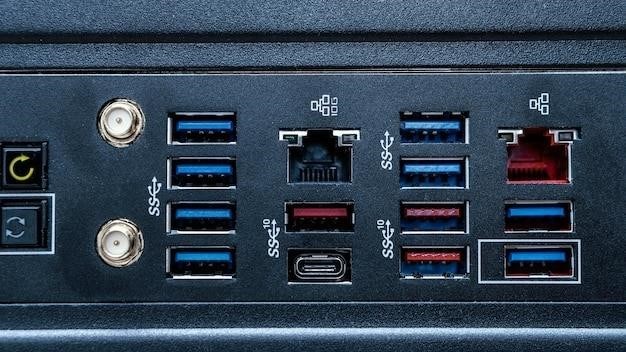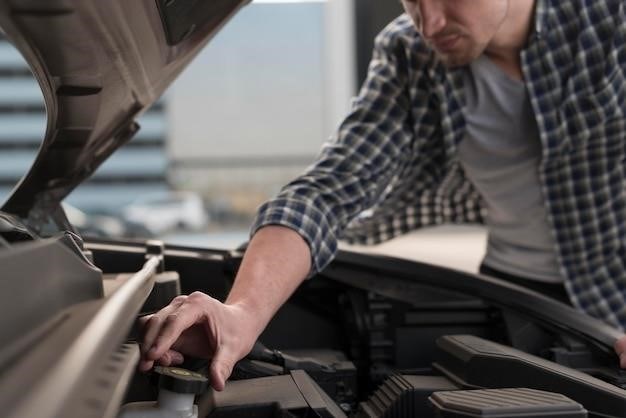DBPOWER Jump Starter Manual⁚ A Comprehensive Guide
This manual provides a comprehensive guide to using your DBPOWER jump starter. It covers everything from charging the jump starter to jump starting your vehicle, using it as a power bank, and safety precautions. It also includes information on troubleshooting common problems and finding the right model for your needs. Whether you’re a seasoned car owner or a novice driver, this manual will help you get the most out of your DBPOWER jump starter.
Introduction
Welcome to the world of DBPOWER jump starters, your trusted companions for those unexpected car battery emergencies. This manual is your comprehensive guide to understanding and utilizing the full potential of your DBPOWER jump starter. Whether you’re a seasoned driver or a newbie behind the wheel, this manual will equip you with the knowledge to confidently handle any situation that might arise.
DBPOWER jump starters are designed to be user-friendly and reliable, providing a safe and efficient solution to jump-starting your vehicle. This manual will guide you through every step, from charging the jump starter to connecting it to your car battery, ensuring a smooth and successful jump-start experience.
Our goal is to empower you with the confidence to tackle any automotive emergency with ease, knowing that your DBPOWER jump starter is there to help you get back on the road quickly and safely. Dive in and discover the many features and capabilities of your DBPOWER jump starter, and learn how to use it to its full potential.
Key Features of DBPOWER Jump Starters
DBPOWER jump starters are engineered to be powerful, versatile, and user-friendly, offering a range of features that cater to diverse needs. These key features make DBPOWER jump starters the ideal solution for anyone looking to stay prepared for unexpected car battery emergencies⁚
- Powerful Jump Starting⁚ DBPOWER jump starters are equipped with high-capacity batteries and powerful jump starting capabilities, designed to easily jump-start a wide range of gasoline and diesel engines. This ensures that you can get back on the road quickly and efficiently, even with a completely dead battery.
- Portable Power Bank⁚ Many DBPOWER jump starters double as portable power banks, allowing you to charge your smartphone, tablet, or other electronic devices. This feature makes them a versatile tool that can handle both car battery emergencies and everyday charging needs.
- Safety Features⁚ DBPOWER jump starters prioritize safety with features like reverse polarity protection, over-current protection, and short-circuit protection; These safeguards prevent damage to your vehicle’s electrical system and ensure safe operation.
- Compact and Durable Design⁚ DBPOWER jump starters are designed to be compact and portable, making them easy to store in your car or carry in your backpack. They are also built with durable materials to withstand the rigors of everyday use.
- Easy-to-Use Interface⁚ DBPOWER jump starters feature a user-friendly interface with clear indicators and intuitive controls, making them easy to operate even for first-time users. This simplifies the jump-starting process and minimizes the chance of errors.
With these key features, DBPOWER jump starters offer a reliable and convenient solution for any driver looking to stay prepared for unexpected car battery emergencies.
Charging the Jump Starter
Keeping your DBPOWER jump starter fully charged is essential for ensuring its effectiveness in jump-starting your vehicle. Here’s a step-by-step guide to charging your jump starter⁚
- Locate the Charging Port⁚ Identify the charging port on your DBPOWER jump starter. It is typically located on the side or bottom of the device.
- Connect the Charging Cable⁚ Plug one end of the included USB-C charging cable into the charging port on the jump starter and the other end into a compatible power adapter.
- Plug in the Power Adapter⁚ Plug the power adapter into a standard electrical outlet.
- Monitor the Charging Process⁚ Most DBPOWER jump starters include LED indicators that show the charging status. The indicators will typically light up during charging and turn off once the jump starter is fully charged.
- Charging Time⁚ The charging time for a DBPOWER jump starter can vary depending on the model and its battery capacity. Refer to the user manual for the specific charging time for your model.
- Full Charge⁚ Once the jump starter is fully charged, unplug it from the power adapter. It is best to keep your jump starter fully charged at all times to ensure it’s ready for an emergency.
It’s important to note that your DBPOWER jump starter might not be fully charged when you receive it. It is recommended to fully charge your jump starter the first time you use it to ensure optimal performance.
Jump Starting Your Vehicle
Using a DBPOWER jump starter to jump-start your vehicle is a relatively straightforward process. However, it’s important to follow the instructions carefully to ensure safety and avoid damaging your vehicle or the jump starter. Here’s a step-by-step guide⁚
- Prepare the Jump Starter⁚ Ensure your DBPOWER jump starter is fully charged. Turn on the jump starter by pressing the power button.
- Connect the Jumper Cables⁚ Connect the red (positive) clamp to the positive terminal of your car battery. The positive terminal is typically marked with a “+” sign. Connect the black (negative) clamp to a metal grounding point on your car’s chassis, away from the battery. Make sure the clamps are securely fastened to avoid any loose connections.
- Start the Vehicle⁚ Turn the key in your vehicle’s ignition to the “start” position. If the vehicle starts, remove the jumper cables in reverse order, starting with the black clamp, then the red clamp.
- Troubleshooting⁚ If the vehicle doesn’t start, check the following⁚
- Ensure the clamps are securely connected to the battery and ground point.
- Verify that the jump starter has enough power.
- If the vehicle still doesn’t start, consult the user manual for troubleshooting tips or contact DBPOWER support.
- Safety Precautions⁚
- Avoid connecting the clamps to the wrong terminals, as this can cause a spark and damage your vehicle or the jump starter.
- Never connect the clamps to the battery while the engine is running.
- Do not touch the clamps or any metal parts while the jump starter is connected to the battery.
Always refer to the user manual for specific instructions and safety precautions related to your DBPOWER jump starter model.
Using the Jump Starter as a Power Bank
In addition to jump-starting your vehicle, many DBPOWER jump starters also function as portable power banks, allowing you to charge your electronic devices on the go. This feature proves particularly useful during camping trips, road trips, or power outages. Here’s how to use your DBPOWER jump starter as a power bank⁚
- Locate the USB Ports⁚ Most DBPOWER jump starters have one or more USB ports. These ports are typically located on the side or top of the device.
- Connect Your Device⁚ Use a USB cable to connect your electronic device, such as a smartphone, tablet, or laptop, to the USB port on the jump starter.
- Charge Your Device⁚ The jump starter will begin charging your device automatically. The charging time will depend on the device’s battery capacity and the jump starter’s remaining power.
- Check the Battery Level⁚ The jump starter typically has a battery level indicator, which shows the remaining power. It’s important to monitor the battery level to ensure you have enough power to charge your devices.
- Disconnect When Finished⁚ Once your device is fully charged, disconnect it from the jump starter to conserve battery power.
Remember that the charging capacity of a jump starter as a power bank is limited. Check the user manual for your specific DBPOWER model to determine the maximum output current and the number of charges it can provide before needing to be recharged.
Safety Precautions
While DBPOWER jump starters are designed to be safe and reliable, it’s crucial to follow certain safety precautions to prevent accidents and ensure your safety. Here are some essential safety tips to keep in mind⁚
- Never connect the jump starter directly to the battery terminals⁚ Always use the included jumper cables to connect the jump starter to the vehicle’s battery.
- Avoid connecting the jump starter to a wet or damaged battery⁚ This could lead to a short circuit or electric shock.
- Wear safety glasses⁚ The jump starter can emit sparks during operation.
- Keep the jump starter away from flammable materials⁚ The jump starter generates heat and could ignite flammable materials.
- Do not use the jump starter in a confined space⁚ The jump starter emits fumes that can be harmful if inhaled.
- Keep the jump starter out of reach of children⁚ The jump starter contains powerful batteries that can be dangerous to children.
- Avoid dropping or damaging the jump starter⁚ This could damage the internal components and make the device unsafe to use.
- Store the jump starter in a cool, dry place⁚ Extreme temperatures can damage the battery and reduce the jump starter’s lifespan.
By following these safety precautions, you can ensure that your DBPOWER jump starter is used safely and effectively. If you have any questions or concerns about using your jump starter safely, consult the user manual or contact DBPOWER support for assistance.
Troubleshooting
While DBPOWER jump starters are generally reliable, you may encounter some issues from time to time. Here are some common troubleshooting tips to help you resolve problems with your jump starter⁚
- Jump starter won’t turn on⁚ Check if the jump starter is fully charged. If it’s not, charge it using the included USB-C cable. Make sure the power button is pressed and held for a few seconds to turn the device on. If the jump starter still won’t turn on, it may be defective.
- Jump starter won’t start the car⁚ Ensure the jump starter is fully charged. Double-check the connection of the jumper cables to both the jump starter and the vehicle’s battery. Make sure the clamps are securely attached and that the red clamp is connected to the positive (+) terminal and the black clamp to the negative (-) terminal. If the jump starter still won’t start the car, the vehicle’s battery may be severely damaged or the jump starter’s capacity may be insufficient for the vehicle’s engine size.
- Jump starter won’t charge⁚ Ensure the USB-C cable is properly connected to the jump starter and the power adapter. If the jump starter still won’t charge, try using a different power adapter or charging cable. If the problem persists, the jump starter may be defective.
- Jump starter overheats⁚ Stop using the jump starter immediately and allow it to cool down. Avoid using the jump starter in extreme temperatures or for extended periods of time. If the jump starter continues to overheat, it may be defective.
If you are unable to resolve the issue, consult the user manual or contact DBPOWER support for assistance. They can provide further troubleshooting steps or advise on repair options.
DBPOWER Jump Starter Models
DBPOWER offers a range of jump starter models to suit different needs and budgets. Here are some popular models⁚
- DBPOWER DJS50⁚ This model features a 800A peak current and 18000mAh battery capacity. It is suitable for petrol engines up to 7.2L and diesel engines up to 9.5L. The DJS50 also includes a USB-C charging cable, a jump starter carry case, and a user manual.
- DBPOWER DJS90⁚ This model boasts a higher peak current of 1600A and a 18000mAh battery capacity. It can jump-start petrol engines up to 8L and diesel engines up to 6.5L. The DJS90 also includes a USB-C charging cable, a jump starter carry case, and a user manual.
- DBPOWER DJS80⁚ This model offers a peak current of 1400A and a 12800mAh battery capacity. It is suitable for petrol engines up to 6.5L and diesel engines up to 5.2L. The DJS80 also includes a USB-C charging cable, a jump starter carry case, and a user manual.
Before purchasing a DBPOWER jump starter, it is important to consider your vehicle’s engine size and the jump starter’s peak current and battery capacity. DBPOWER also offers other models with varying features and specifications. Visit their website or consult their user manuals for detailed information on each model.

Where to Find the Manual
The DBPOWER jump starter manual is typically included in the package when you purchase the device. It’s a handy little booklet that provides all the necessary information for using and maintaining your jump starter. However, if you’ve misplaced your manual or need a digital copy, there are several ways to find it⁚
- DBPOWER Website⁚ The DBPOWER website is a great resource for finding user manuals for all their products. You can navigate to their support section, where you can search for your specific jump starter model and download the manual in PDF format. The manual is often available in multiple languages, ensuring you understand the instructions clearly.
- Amazon Product Page⁚ If you purchased your DBPOWER jump starter from Amazon, you can often find the user manual linked on the product page. Look for a “Technical Details” or “Product Information” section, where the manual might be listed as a downloadable document. This is a convenient way to access the manual without leaving the platform.
- Online Retailers⁚ Other online retailers where you might have purchased your DBPOWER jump starter might also provide access to the user manual. Check the product page or contact their customer support for assistance. They may have a downloadable version or provide a link to the DBPOWER website for the manual.
By following these steps, you can easily find the DBPOWER jump starter manual and gain access to all the information you need to use your device safely and effectively.










